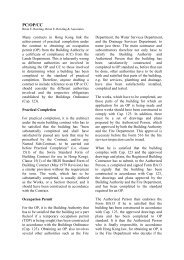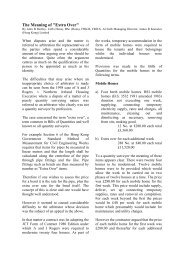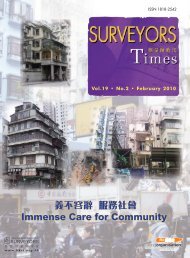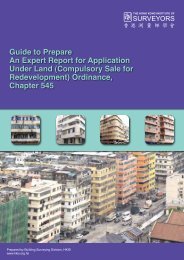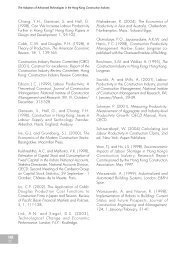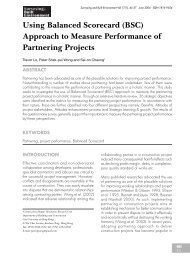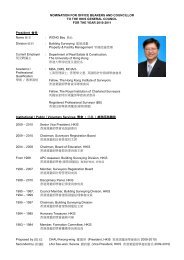Special issue to commemorate the 70th Anniversary of the Battle of ...
Special issue to commemorate the 70th Anniversary of the Battle of ...
Special issue to commemorate the 70th Anniversary of the Battle of ...
You also want an ePaper? Increase the reach of your titles
YUMPU automatically turns print PDFs into web optimized ePapers that Google loves.
Decoding <strong>the</strong> Enigma <strong>of</strong> <strong>the</strong> Fall <strong>of</strong> <strong>the</strong> Shing Mun Redoubt Using Line <strong>of</strong> Sight Analysis<br />
Figure 6: View <strong>of</strong> <strong>the</strong> Shing Mun Redoubt from Needle Hill area<br />
CONCLUSION<br />
We carried out a land survey exercise for <strong>the</strong> Shing<br />
Mun Redoubt due <strong>to</strong> a number <strong>of</strong> bewildering questions<br />
that arose from our documentary analysis. Why were<br />
<strong>the</strong>re so few casualties for a fight that both sides <strong>to</strong>ok<br />
so seriously (especially <strong>the</strong> defenders)? The defenders’<br />
post-war consensus was that <strong>the</strong> attack first hit <strong>the</strong> OP<br />
and <strong>the</strong>n swept northwards <strong>to</strong>wards PB401 and PB402,<br />
but <strong>the</strong> Japanese account showed that it was a direct<br />
north-south movement that branched <strong>of</strong>f <strong>to</strong> catch <strong>the</strong><br />
15 <strong>to</strong> 20 mysteriously trapped soldiers in a position<br />
(factually separate from <strong>the</strong> rest <strong>of</strong> <strong>the</strong> redoubt in terms<br />
<strong>of</strong> tunnel connection) with at least three exits, which<br />
a site visit could easily establish. So <strong>the</strong> defenders’<br />
explanation that <strong>the</strong>y were locked in from <strong>the</strong> outside<br />
by a private had <strong>to</strong> be incomplete.<br />
Whe<strong>the</strong>r <strong>the</strong> construction <strong>of</strong> a redoubt with pillboxes<br />
connected by underground tunnels could enable a<br />
numerically inferior garrison <strong>of</strong> 42 soldiers, slightly<br />
larger than one pla<strong>to</strong>on, stationed at lower ground <strong>to</strong><br />
resist for a considerable period <strong>of</strong> time a full regiment<br />
<strong>of</strong> a determined enemy attacking from a commanding<br />
height (Needle Hill) and enjoying a good view <strong>of</strong> <strong>the</strong><br />
defenders’ exposed positions was an <strong>issue</strong> on which<br />
this paper attempted <strong>to</strong> shed some light.<br />
This pr<strong>of</strong>essional land survey <strong>of</strong> <strong>the</strong> Shing Mun<br />
Redoubt, based on questions <strong>of</strong> documentary analysis,<br />
is <strong>the</strong> first <strong>of</strong> its kind for any battlefield in Hong Kong<br />
or elsewhere in Asia that was defended by <strong>the</strong> British.<br />
It employed techniques used by <strong>the</strong> surveying industry<br />
and GIS researchers, and <strong>the</strong> findings are useful not<br />
only for his<strong>to</strong>rians and enthusiasts <strong>of</strong> a small battle in<br />
a small <strong>the</strong>atre <strong>of</strong> war in <strong>the</strong> Pacific during World War<br />
II, but also for heritage conservationists. The line <strong>of</strong><br />
sight analysis was pivotal in locating and disseminating<br />
information on <strong>the</strong> vantage points <strong>of</strong> a heritage<br />
site. The results <strong>of</strong> our analysis are <strong>of</strong> immediate<br />
practical use for <strong>the</strong> battlefield <strong>to</strong>urist development<br />
<strong>of</strong> Shing Mun Reservoir as part <strong>of</strong> a looming heritage<br />
conservation movement in Hong Kong, while <strong>the</strong><br />
methods used should serve as a solid reference for<br />
developments elsewhere.<br />
REFERENCES<br />
Badsey S (2002), Terrain as a Fac<strong>to</strong>r in <strong>the</strong> <strong>Battle</strong> <strong>of</strong><br />
Normandy, 1944, Fields <strong>of</strong> <strong>Battle</strong>: Terrain in Military<br />
His<strong>to</strong>ry, Doyle, Peter and Bennett, Ma<strong>the</strong>w R (eds.),<br />
Kluwer Academic Publishers, Dordrecht, Ne<strong>the</strong>rlands,<br />
345-363.<br />
Banham T (2003), Not <strong>the</strong> Slightest Chance: <strong>the</strong><br />
Defence <strong>of</strong> Hong Kong, 1941, Hong Kong University<br />
Press, Hong Kong.<br />
Dakowicz M and Gold CM (2003), Extracting<br />
M e a n i n g f u l S l o p e s f r o m Te r r a i n C o n t o u r s ,<br />
International Journal <strong>of</strong> Computational Geometry and<br />
Applications, 13:4, 339-357.<br />
Direc<strong>to</strong>r <strong>of</strong> Public Works (1937), Report <strong>of</strong> <strong>the</strong> Direc<strong>to</strong>r<br />
<strong>of</strong> Public Works for <strong>the</strong> Year 1937, Public Works<br />
Department, Hong Kong.<br />
Doi T (1952), <strong>Battle</strong> Progress Report <strong>of</strong> <strong>the</strong> 228th<br />
Infantry Regiment in <strong>the</strong> Hong Kong Invasion<br />
Operation in December 1941, PRO record.<br />
Doyle P and Bennett MR (2002), Terrain in Military<br />
SBE<br />
40




